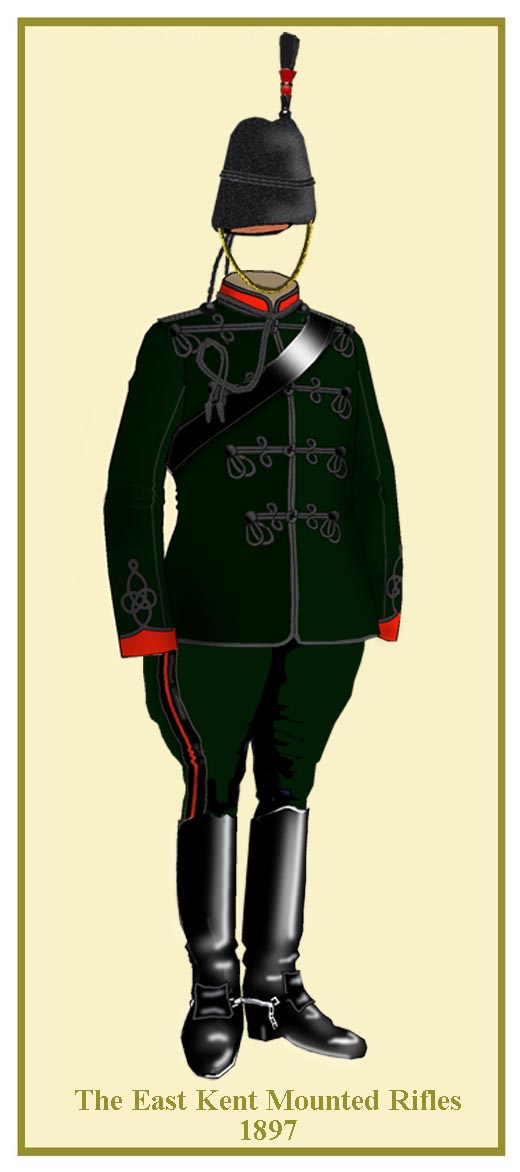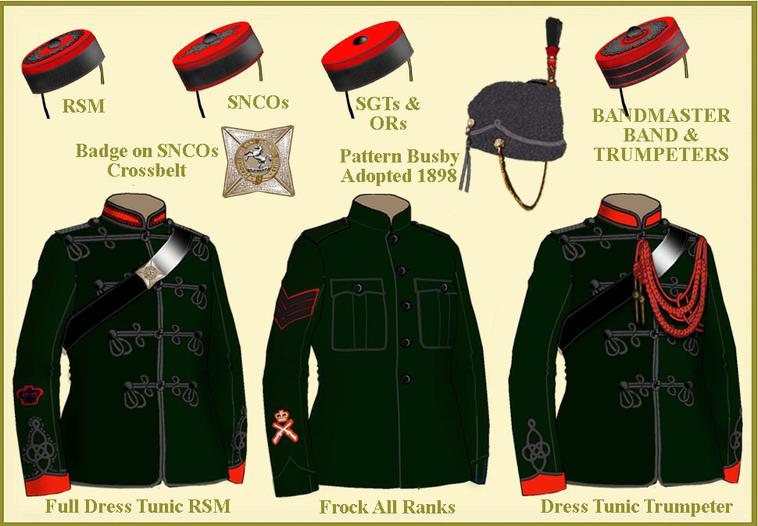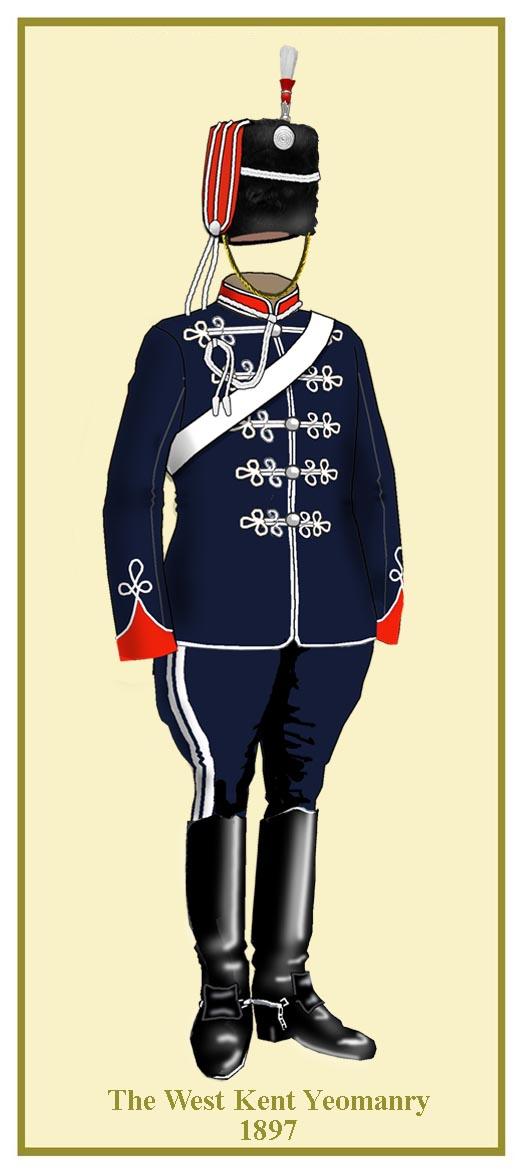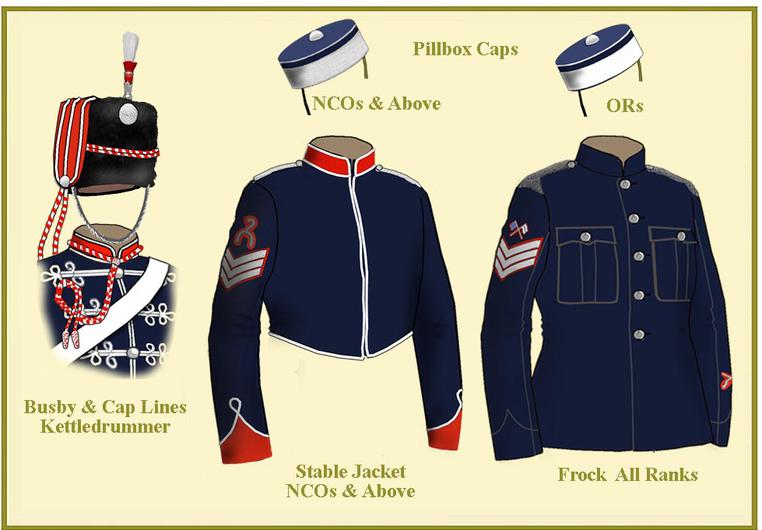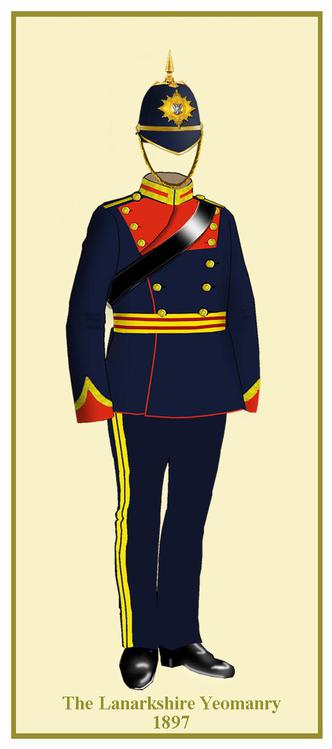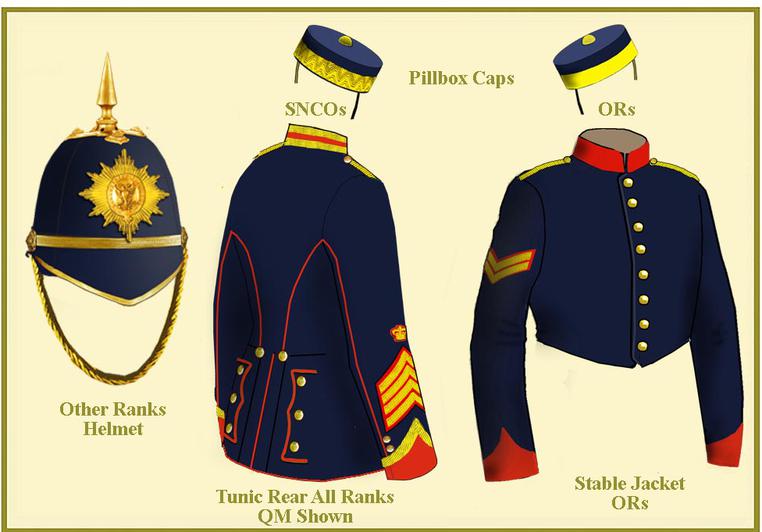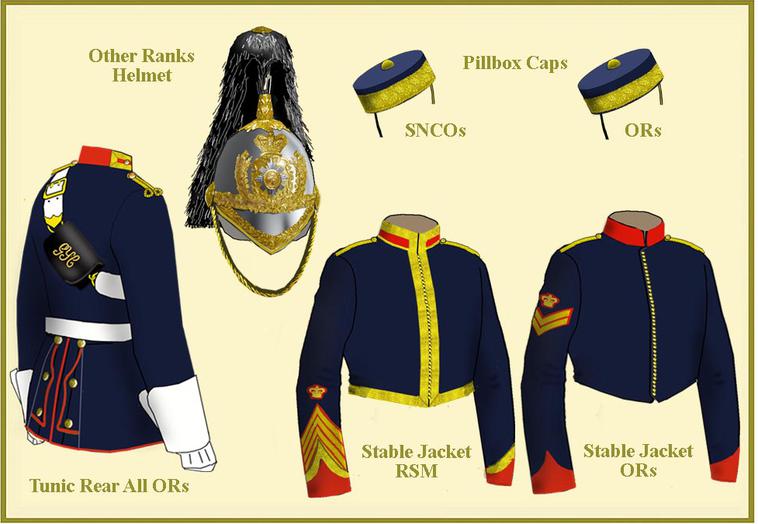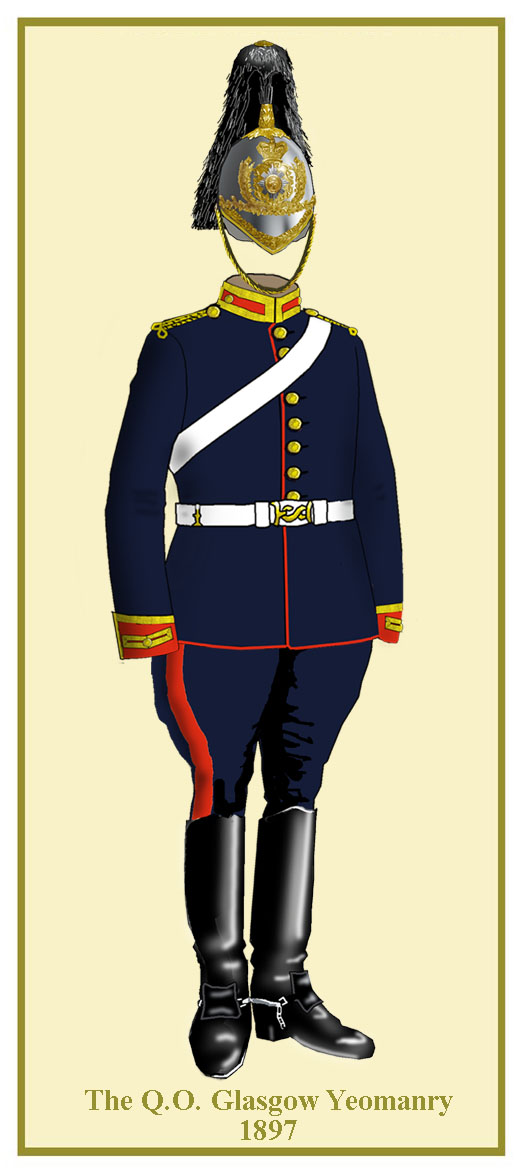The Royal East Kent Mounted Rifles (Duke of Connaught's Own)
Ranked No. 19 in Yeomanry Order of preference
A number of independent troops throughout Kent were formed in 1794. Some of these corps were amalgamated in 1803 but were not fully regimented until about 1813. They were disbanded in 1828 but reformed in 1830. In 1853 they became the East Kent Mounted Rifles and because of their services as Royal escorts received the title Royal East Kent Mounted Rifles (Duke of Connaught's Own) in 1856.
Formed 33rd Coy of 11th Bn Imperial Yeomanry in 1900
UNIFORMS OF THE BRITISH YEOMANRY REGIMENTS 1895-1900
PART 4
Uniforms
Information on the early uniforms of the regiment is scarce. An existing long tailed coat of an officer of the Provender troop is blue with scarlet collar and cuffs with cords of black lace on the front and silver buttons. The helmet was probably in the Tarleton style. Other surviving items from the 1820’s are a light cavalry jacket heavily laced in front in silver with scarlet collar and cuffs and a later model Tarleton helmet. When the regiment was re-raised in 1830 they wore the current light dragoon uniform consisting of a double breasted blue jacket with light yellow/buff collar and cuffs and a double row of white metal buttons down the front. A bell topped shako was worn with the large white horse of Kent above the scroll “INVICTA” on the front and a drooping black plume. Trousers were dark blue. This uniform survived largely unchanged until 1854 when after being designated Mounted Rifles they adopted a completely different uniform. This was a mid grey hussar tunic with four black loops across the front and black edging all round with Austrian Knots on the cuffs. Facings were scarlet and the jacket was edged down the front with scarlet and black leather belt was worn. A hussar busby with scarlet bag was worn and the trousers were also grey with a wide black lace with a central scarlet light.
In 1863 it was decided that Rifle Green was the appropriate colour for mounted rifles and the uniform was thus changed. The tunic continued to have four rows of lace with caps & drops and it retained the Austrian knots and the trouser lace with scarlet light. The headdress was somewhat unique and resembled a tall tapered shako without peak and covered in lambskin. The plume was black out of red and the black caplines were worn in the same manner as hussars. This headdress was worn until 1897. Dark green pantaloons and riding boots were introduced in 1879. All other ranks wore black leather pouch belts and pouches with the RSM and senior NCOs wore a bronze Maltese cross on the front with the Kentish Horse & INVICTA in the center. Black rank chevrons and crowns were worn by NCOs on a scarlet backing. The regiment never wore stable jackets and it has been assumed they probably wore a best uniform and a drill/exercise uniform of worn out items. The pill box caps for other ranks were basically scarlet with black bands and edging to the top edge. The RSM wore an Officer’s (rounded) pattern with black figuring on the crown, SNCOs wore the same as other ranks with extra black lace & figuring on the crown, while the band and bandmaster wore one with additional lights of scarlet showing through the headband. Trumpeters wore scarlet aiguillettes on the left shoulder (similar to dragoon guards & dragoons). In 1897 rifle green five button frocks with breast pockets was introduced for field wear and in 1900 the frogged tunic was abolished. The following year a busby patterned more like that of contemporary rifle jackets was adopted. Unfortunately this headwear lasted only two years before being discontinued.
After the Boer War khaki uniforms were worn, the jacket having black collar and cuffs piped scarlet and a slouch hat with green, black & scarlet pugarree with same plume as on busby was also worn. A peaked staff pattern cap was introduced which was rifle green with a black band and the flat top of the cap was scarlet. This cap with the old rifle green frogged tunic and trousers were worn at George Vths coronation.
The Queen's Own West Kent Yeomanry
Ranked No. 19 in Yeomanry Order of preference
A troop of Yeomanry was raised early in 1794 as the Cinque Ports corps but others were not raised until 1797. Little is known of its subsequent history except that it was disbanded in 1827. Raise again in 1831 it became received the title Queen’s Own West Kent Yeomanry in 1864 for services to the crown
Formed 36th Coy of 11th Bn Imperial Yeomanry in 1900
Uniforms
The early uniforms of the West Kent corps are as difficult to trace as many of the yeomanry of the same era. It is likely that blue uniforms and Tarleton helmets were the norm. After its reincarnation in 1831 the regiment wore a light dragoon uniform of blue jacket with scarlet plastron, collar and cuffs, light blue trousers with scarlet stripe and bell topped shako with white metal Kentish Horse. By the 1850s this uniform had evolved to dark blue jacket with double row of buttons and red striped trousers with an Albert pattern shako with gold lace. A red and white girdle was also worn. In 1855 a dark blue tunic was taken into wear. This had scarlet collar and cuffs and was piped white all round including the skirts. It had white Austrian knots on the cuffs and the booted overalls with double scarlet stripes. They wore a rather low busby with scarlet bag and white caplines. The plume was white. In 1868 the other ranks trouser stripes were changed to red. The tunic was changed to an unusual hussar pattern in 1876. This had five rows of straight white frogging across the front ending in trefoils and fastening with white metal buttons. There were white piped vents on the tunic sides and the cuffs also had trefoils.
In 1880 the regiment exchanged their low busbies for a taller version, probably of the 1857 pattern. These remained in use until they were abolished in 1900. A new tunic was introduced the following year which differed to the previous one by having eyes on the frogging looped between the trefoil and the buttons and the disappearance of the side vents. Pantaloons and knee boots were adopted in 1886. NCOs wore their chevrons on scarlet backing. Stable jackets were the same for all ranks except SNCOs. They were piped all round with white cord with white metal buttons down the front. Sergeants and SNCOs had silver piping with the front secured by hooks and eyes. In 1898 dark blue five button frocks with shoulder chains were introduced and the old hussar jackets were put into store. The regiment had a mounted band whose only uniform distinctions were red and white busby cap lines.
After the Boer War the regiment went into Khaki with red collars and cuffs and slouch hats. In 1908 a plain blue staff pattern cap was adopted and was worn with the blue frock. At George Vths coronation in 1911 the contingent wore the old hussar tunics with regulation height busbies (probably borrowed).
The Lanarkshire Yeomanry
Ranked No. 13 in Yeomanry Order of preference
Raised in 1819 as independent troops in the county, they were regimented from the remaining five troops in 1848 as the Upper Ward and Airdrie Corps of Lanarkshire Yeomanry Cavalry. In 1852 it was retitled as the Lanarkshire Regiment of Yeomanry Cavalry.
Formed 17th Coy of 6th Bn Imperial Yeomanry in 1900
Uniforms
There is very little information on the dress of this unit much before the 1850s. In 1848, the Lanarkshire Yeomanry wore a regulation dark blue light dragoon uniform with scarlet collar and cuffs. Both collar and cuffs were edged with gold lace, which unusually was worn by all ranks. An Albert pattern shako was also worn with gold lace hangers and a star shape badge with the double headed eagle in the centre. In 1860 the coatee was replaced with the current regulation double breasted lancer tunic. This was blue with scarlet collar and pointed cuffs all edged in half-inch gold lace. The plastron was also scarlet with the lapels folded back and over as they were in the line regiments. The edges of the tunic and rear seams were piped scarlet as were the three pointed flaps on the skirts. A yellow and red girdle was worn along with a black leather pouchbelt and pouch. Trousers were blue with scarlet double stripes. The Albert pattern helmet with star badge was still in use in 1881 and it was worn with a black cock’s feather plume. The shako was apparently still festooned with lace. In 1884 the infantry pattern helmet was introduced. This had a brass band around the waist and down the back with brass band, peak edging and appointments. At the same time pantaloons and knee boots were adopted for mounted duties. In 1895, the scarlet stripes on the pantaloons and overalls were changed to yellow. NCOs chevrons were gold lace on scarlet backings. Stable jackets were plain blue with scarlet collar and cuffs. NCOs wore blue pillboxes with gold lace bands while other ranks were yellow.
After the Boer War, the regiment wore khaki and it is not known whether there were coloured collars or not. Blue frocks with blue staff pattern caps with scarlet bands, piping and scarlet lancer welts were worn after 1908. A full dress lancer cap was adopted by officers in about 1910 but not worn by the men. Strangely, at the 1911 coronation they wore plain khaki uniforms with khaki caps.
The Queen's Own Royal Glasgow Yeomanry
Ranked No. 37 in Yeomanry Order of preference
The Glasgow Light Horse was the first unit raised in the city in 1797 but was disbanded in 1802, reraised in 1804 only to be disbanded ten years later. A troop was again raised in 1819 but it only lasted three years. A new regiment known as The Glasgow and Lower Ward of Lanarkshire Yeomanry Cavalry was raised in 1848. They were allowed to add the title of "Queen's Own Royal" after escorting Queen Victoria in 1849.
Formed 17th Coy of 6th Bn Imperial Yeomanry in 1900
Uniforms
Like its brother corps in the other part of the county, the Glasgow yeomanry possesses little information on its uniforms before the middle of the century. An existing Tarleton helmet worn by the original corps has a light blue turban and silver appointments. On the right side there is a semi-circular brass plate with the word “GLASGOW” inscribed. Above was a brass “GR” surmounted by a crown. The new regiment raised in 1848 took up a uniform very similar to the Royal Horse Guards pre Crimean dress. The coatee was dark blue with scarlet collar and gauntlet cuffs all edged gold. The trousers were also blue with a scarlet stripe. The Albert pattern heavy cavalry helmet was white metal with brass fittings and a black horsehair plume. In 1858 the tunic was adopted. This again was based on the 1855 pattern Household Cavalry tunic albeit with significant differences. The nine button tunic had scarlet collar and gauntlet cuffs. The collar had a gold lace loop on either side with a brass button. The cuffs were edged round the top and back with gold lace and there was a chevron with a brass button at the point. The tunic was piped scarlet down the front and lower skirt edges and the rear skirts departed from the Household Cavalry style with the old 1857 Infantry tunic style flaps with two buttons on the points and two buttons at the waist. The shoulder straps were in fact two twisted cords with two loops on the end. The helmet remained the same as it was in 1848 with black horsehair plume. The scarlet stripe on the overalls and pantaloons (which along with knee boots were introduced in about 1890) were 2” wide. A white pouchbelt was worn with a black leather pouch which had a gilt “GYC” on the flap. Sword belts were worn under the tunic and a white belt with snake clasp was worn around the waist. White gauntlets were worn. Chevrons and crowns were worn on scarlet backings. All ranks above corporal wore a crown above the badge.
Stable jackets for privates and junior NCOs were plain blue with scarlet collars and pointed cuffs. The jacket was secured by hooks and eyes and a row of small buttons decorated the front edge of the jacket. SNCOs wore a jacket with gold lace all round on collar, cuffs and front. Pillbox caps were blue with wide gold lace for Sergeants and above and narrower gold lace for other ranks.
Following the Boer War records are also scarce, but khaki uniforms were worn with the slouch hat. In 1908 the regiment was wearing blue frocks with dark blue staff pattern caps with scarlet bands and piping. At the 1911 coronation they turned out in full dress tunics with white belts and scarlet striped trousers with the old Albert pattern helmets with black plumes and the Victorian crown changed to Tudor.
East Kent Mounted Rifles
West Kent Yeomanry
Lanarkshire Yeomanry
Royal Glasgow Yeomanry



